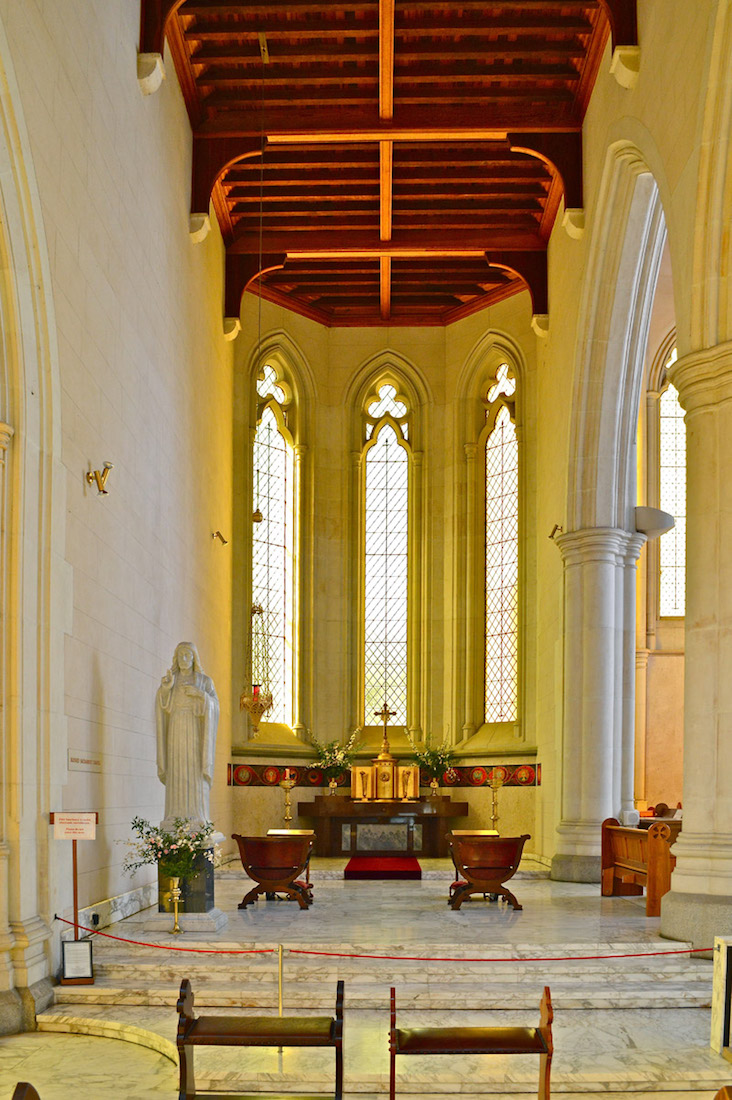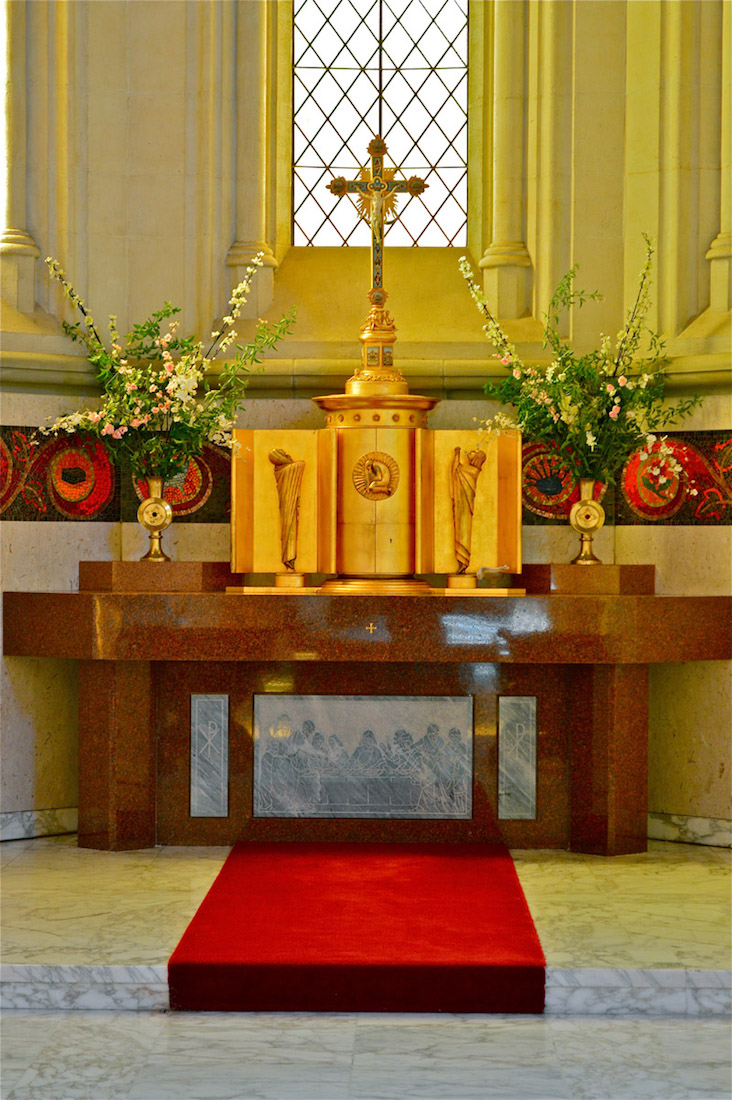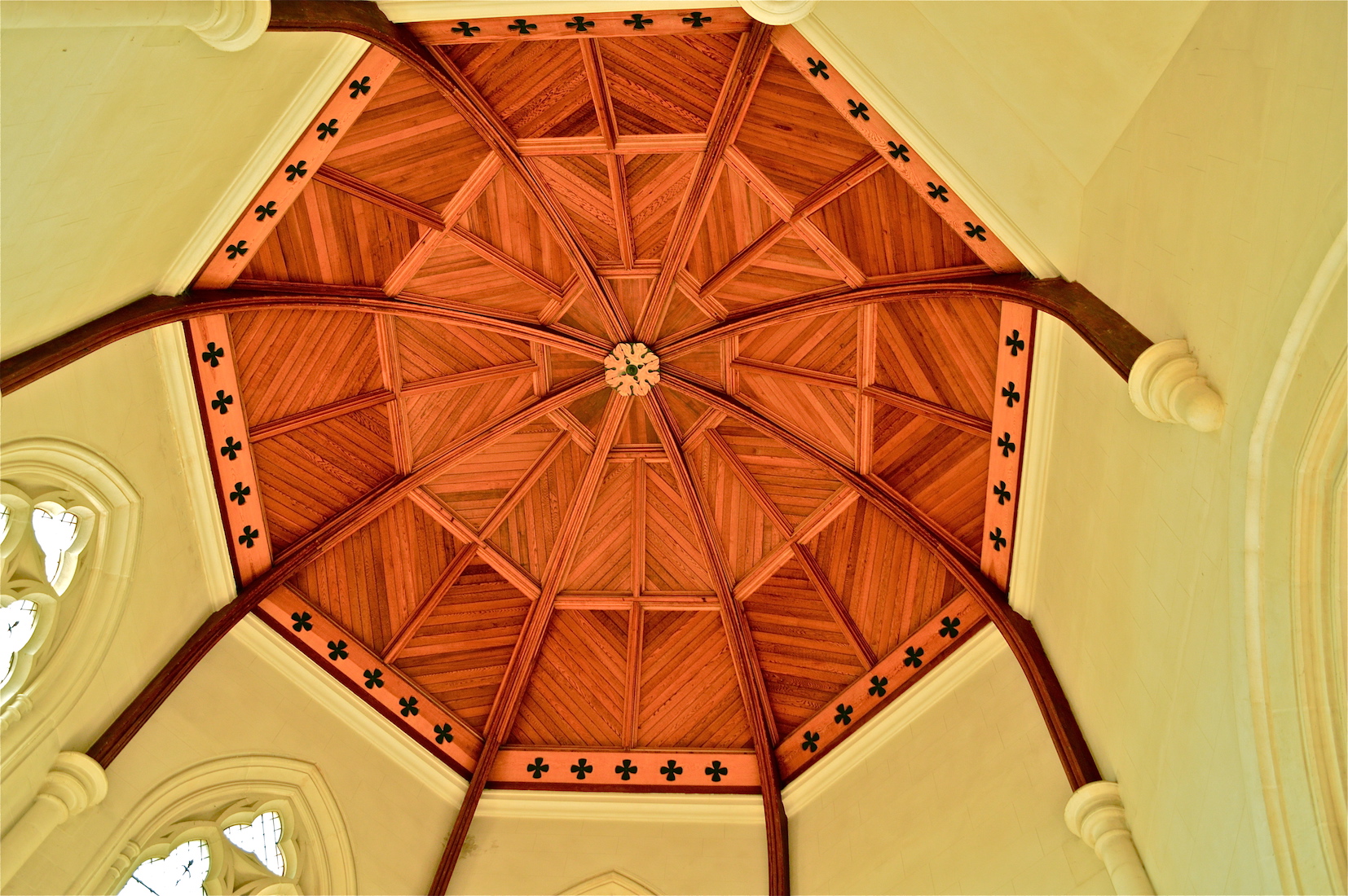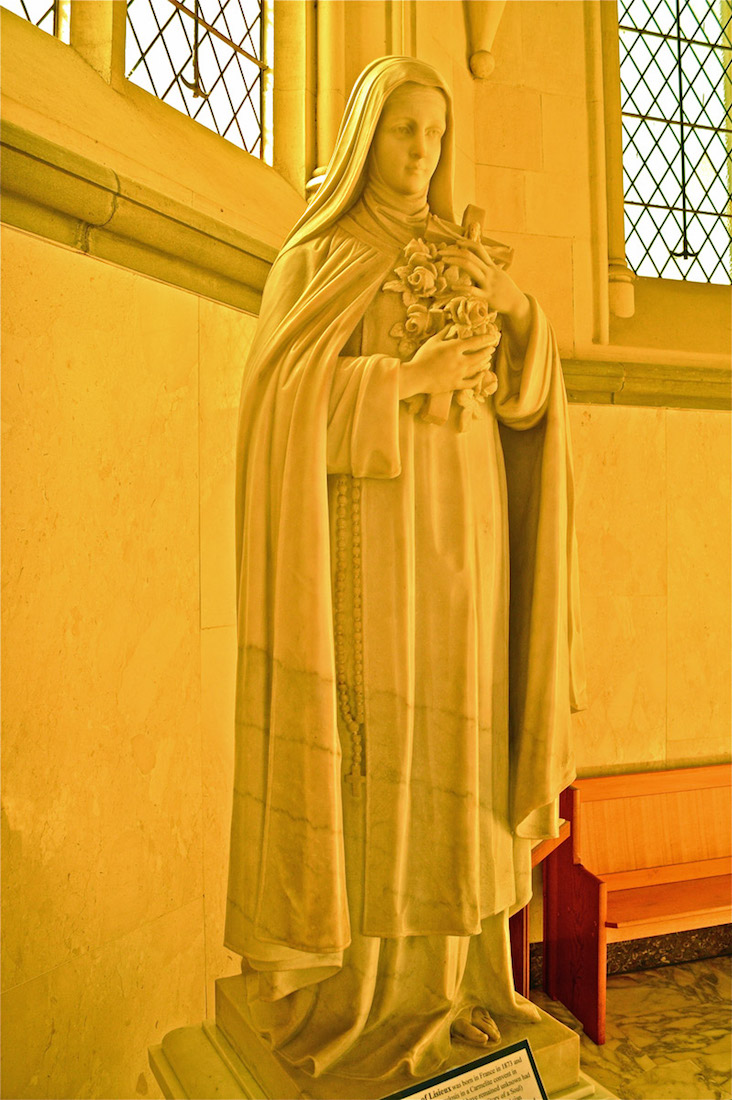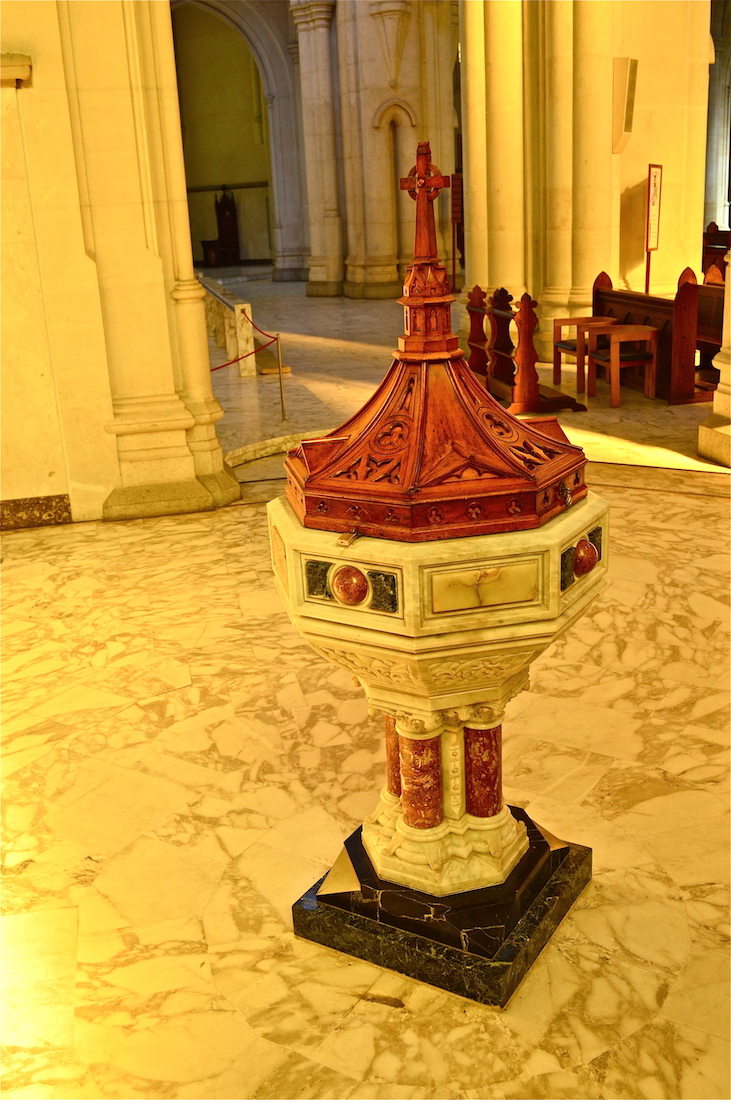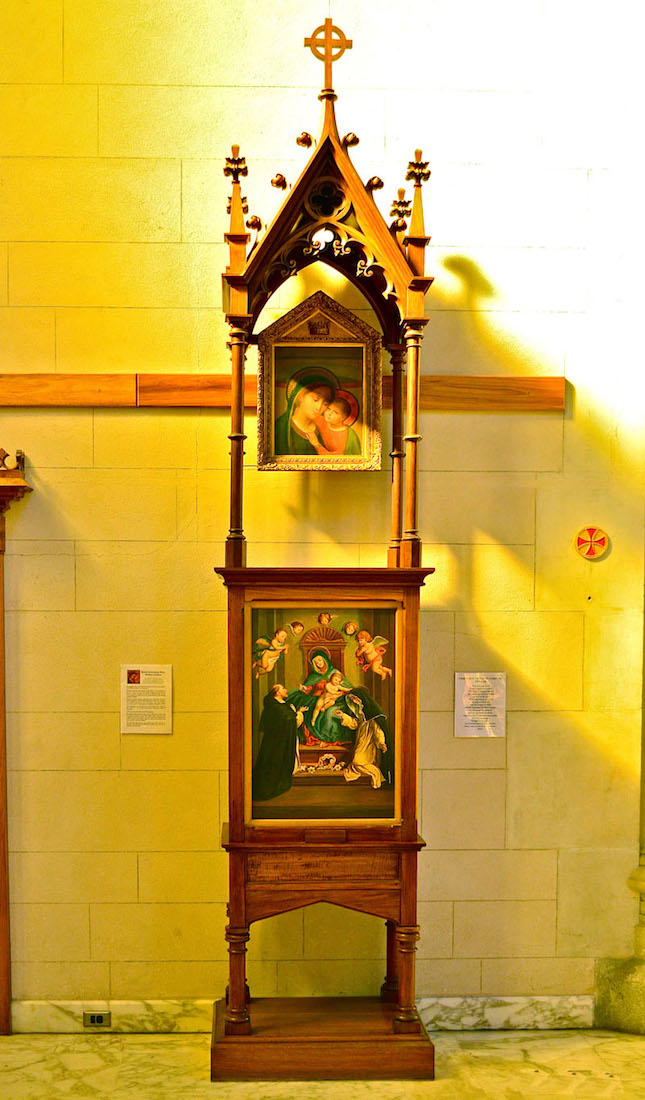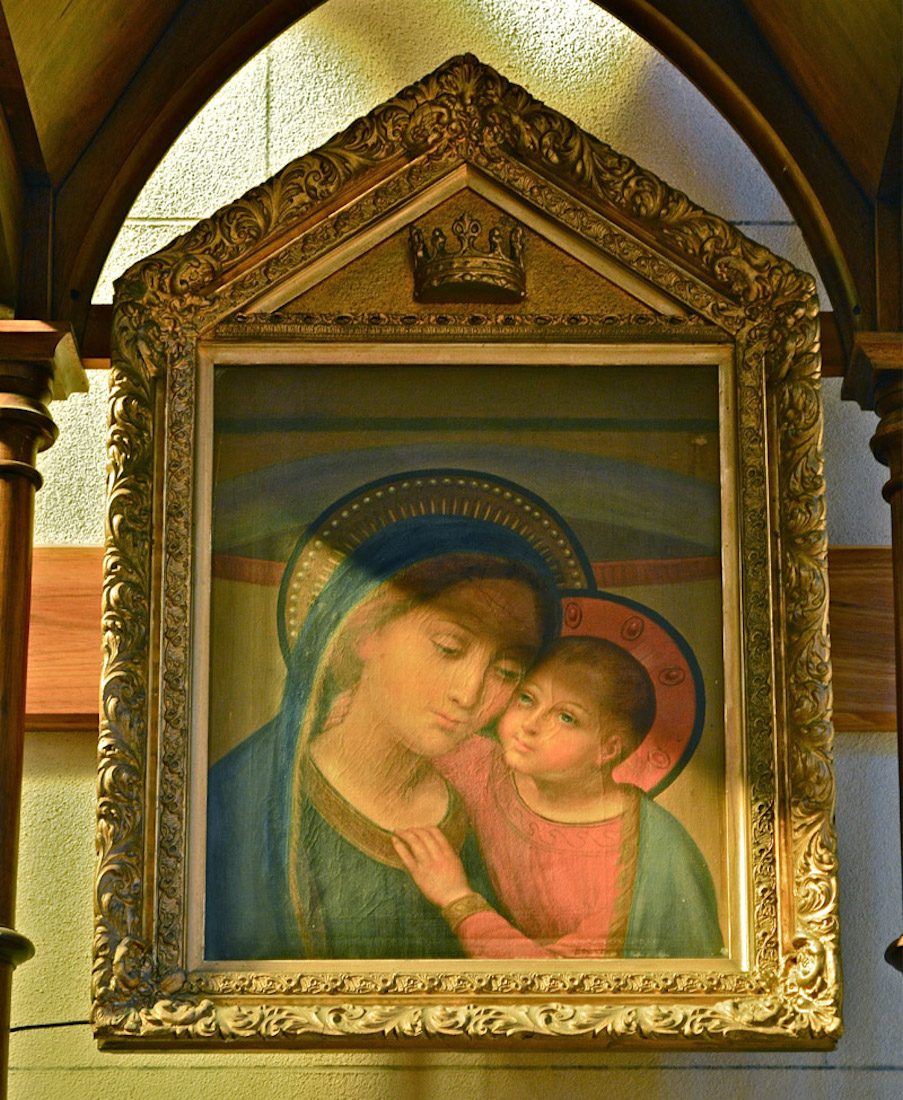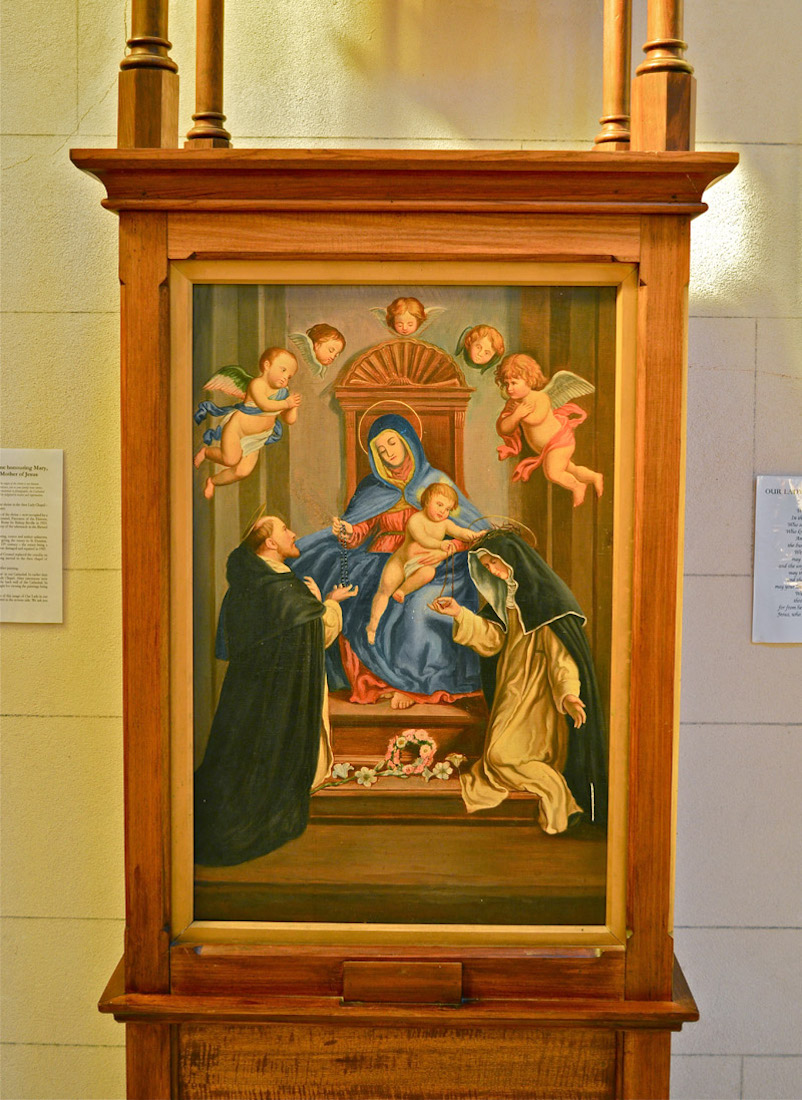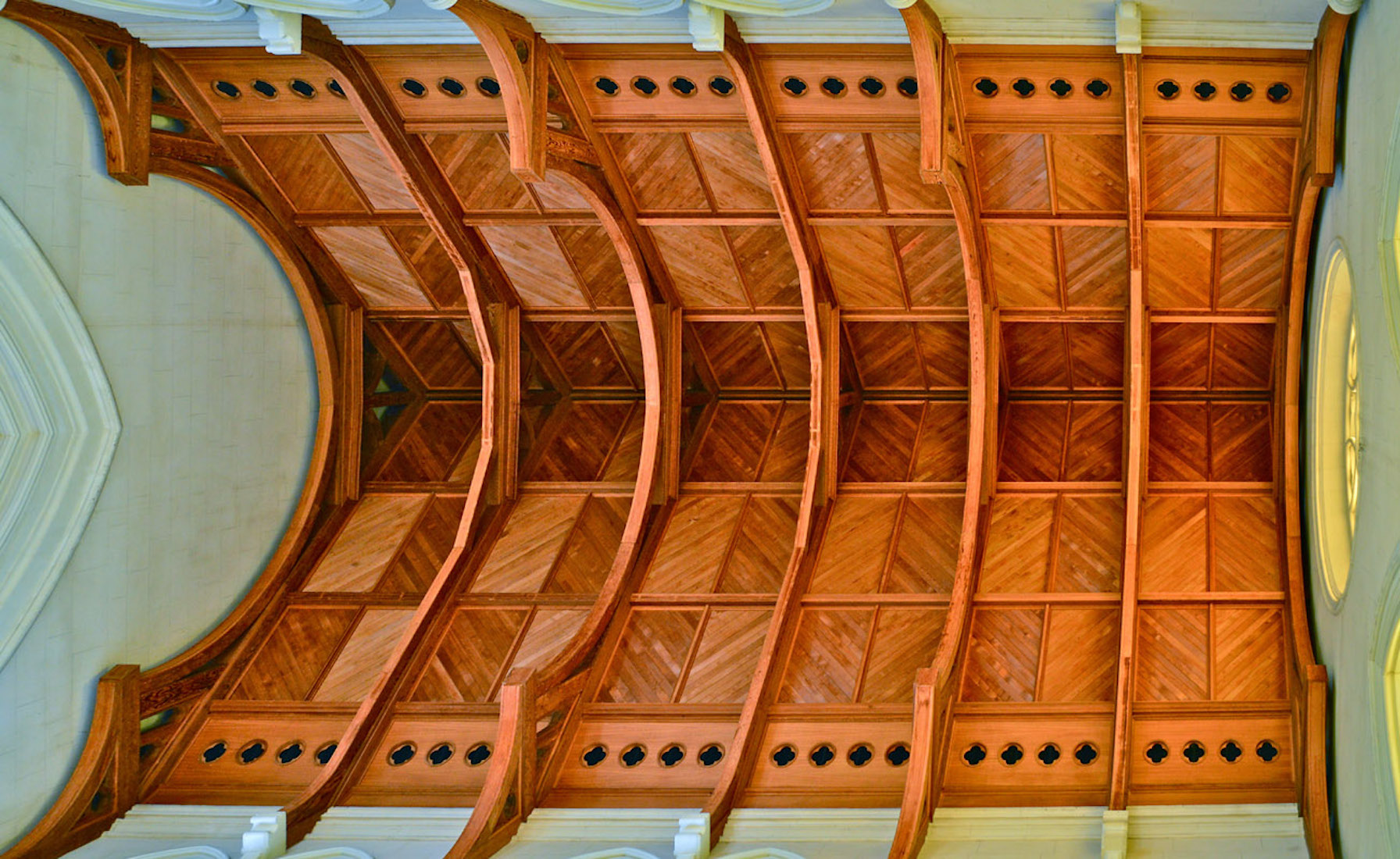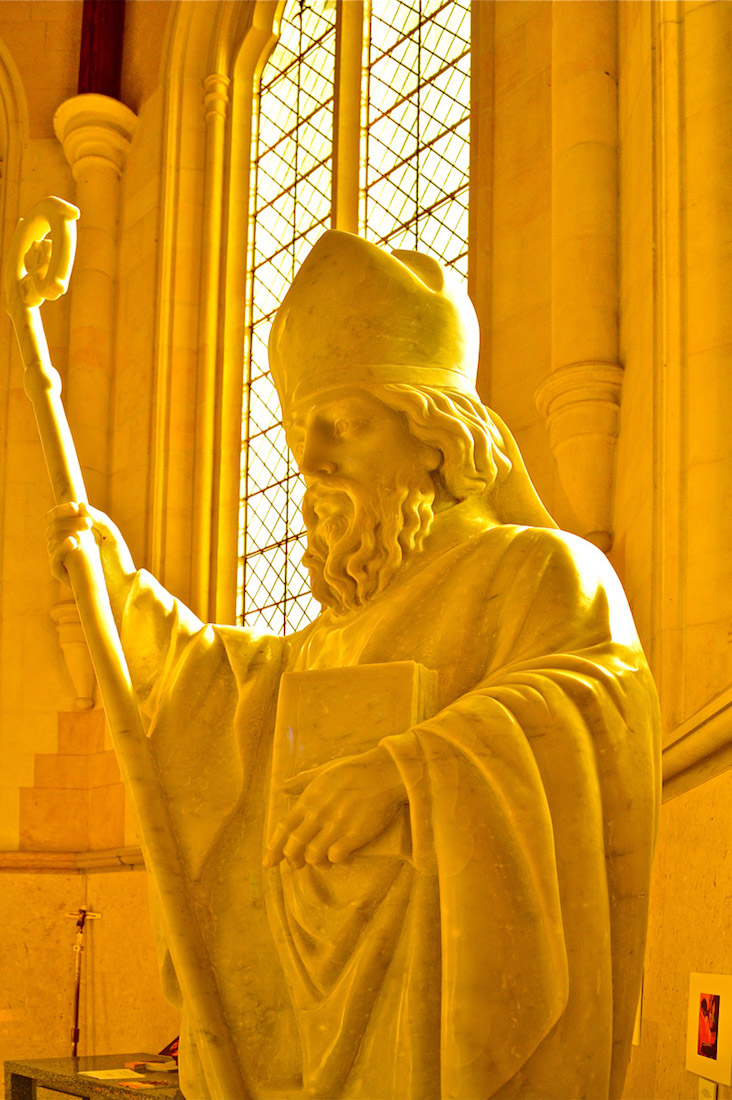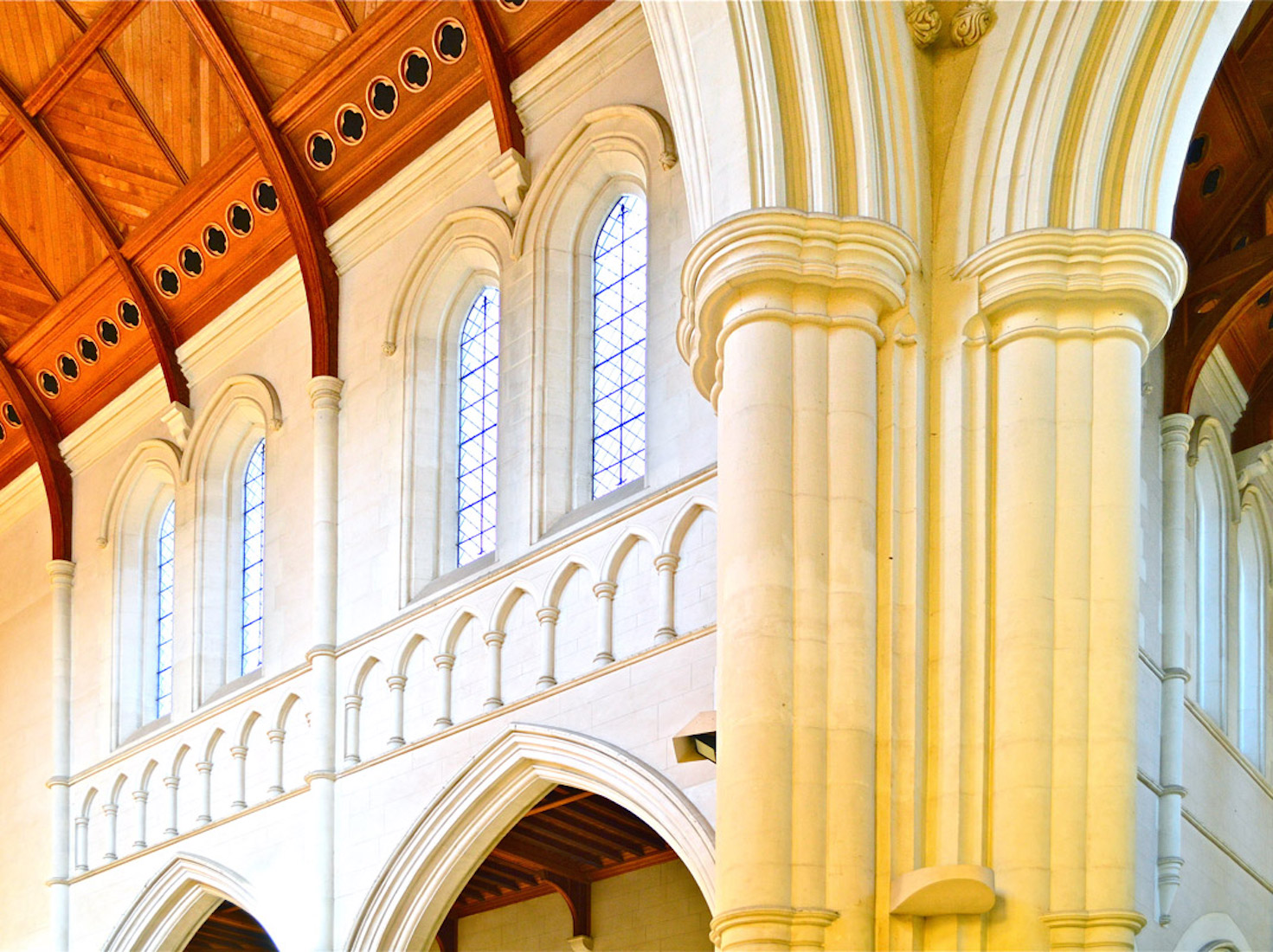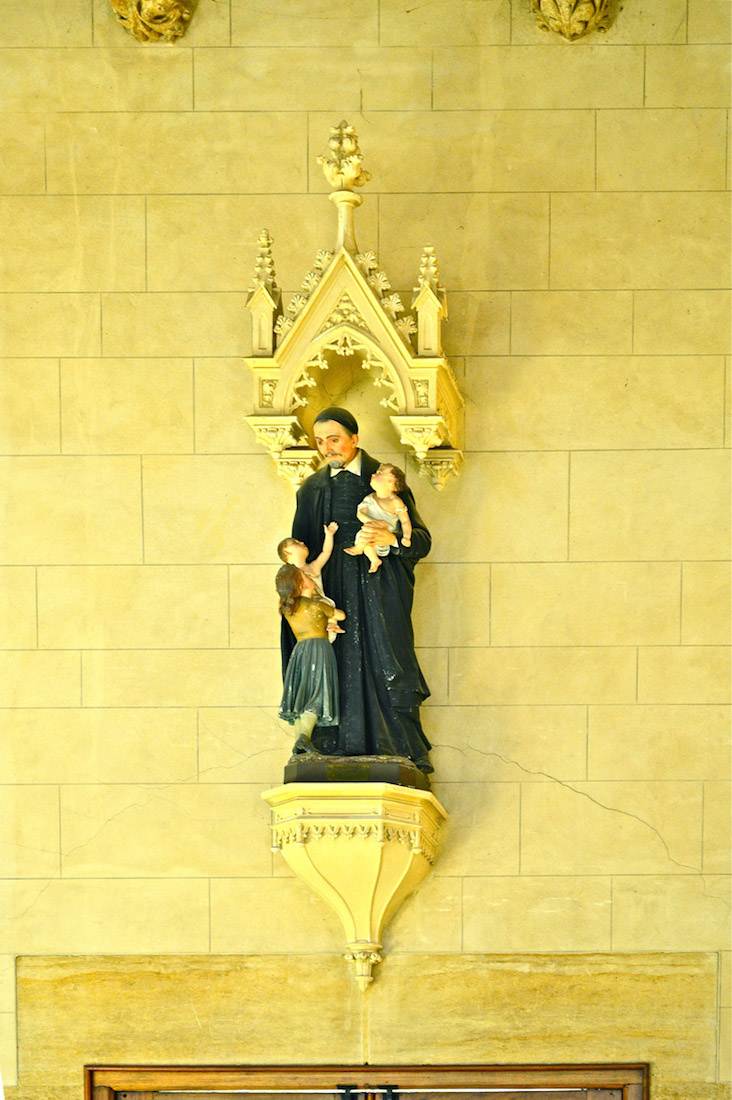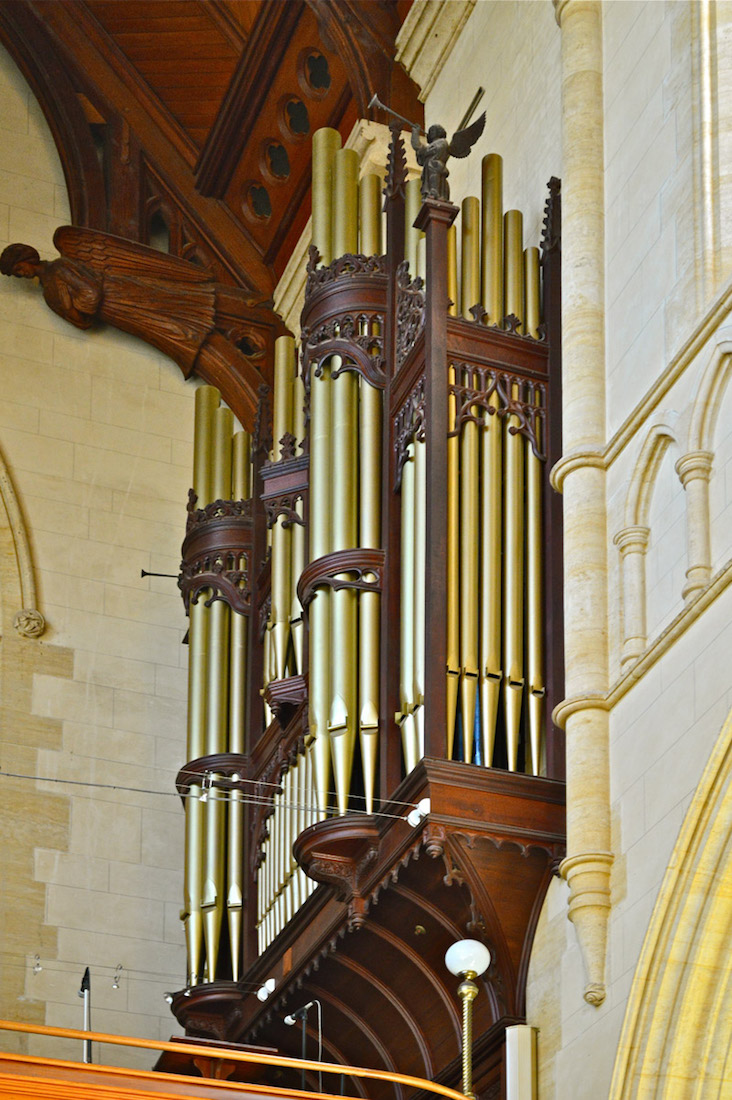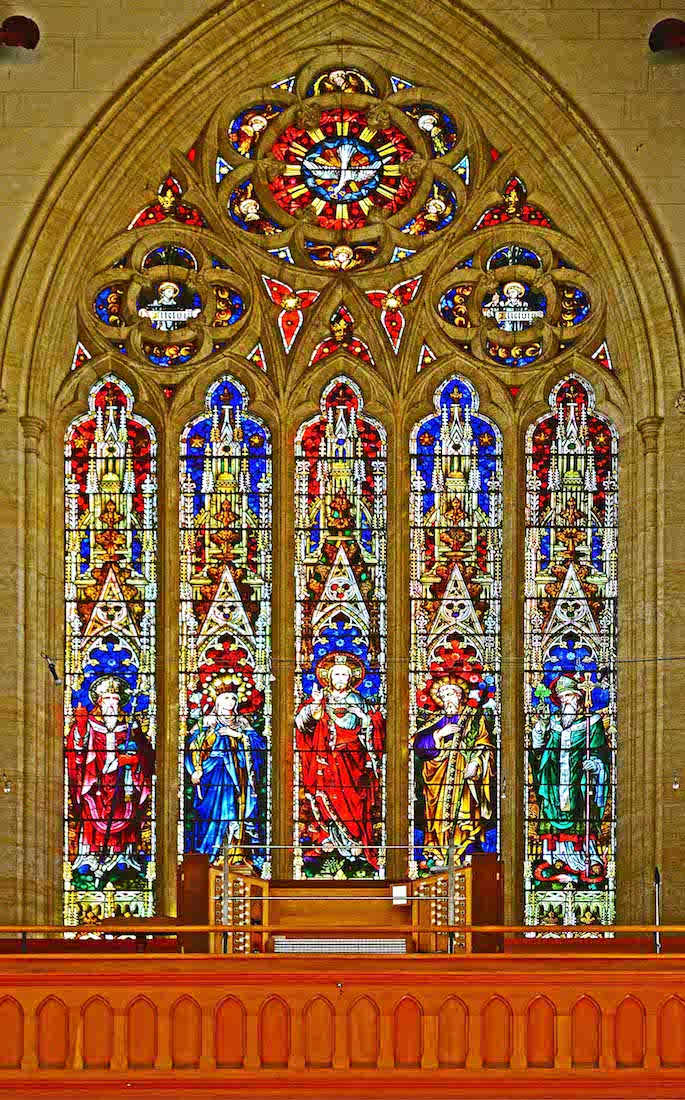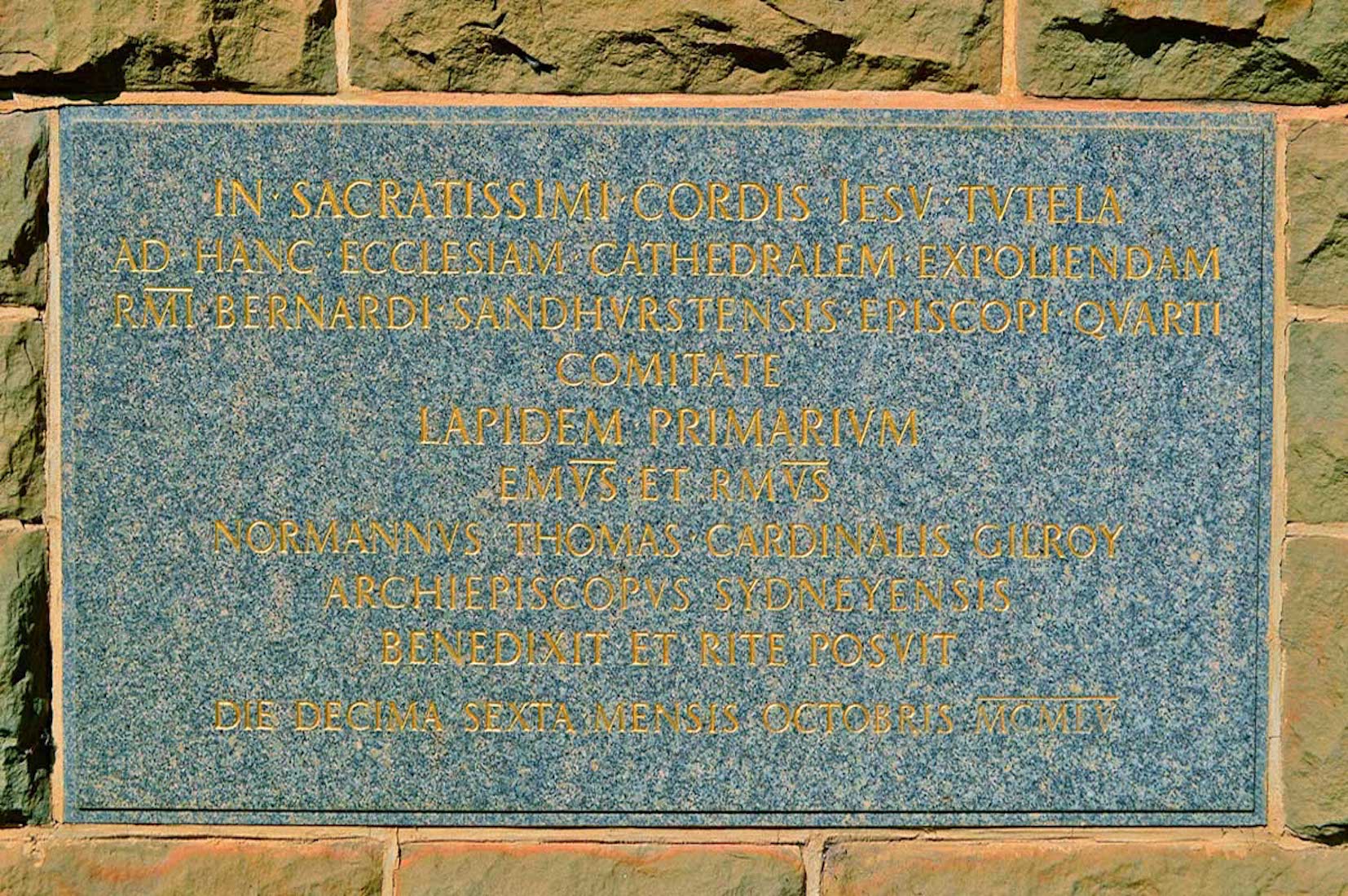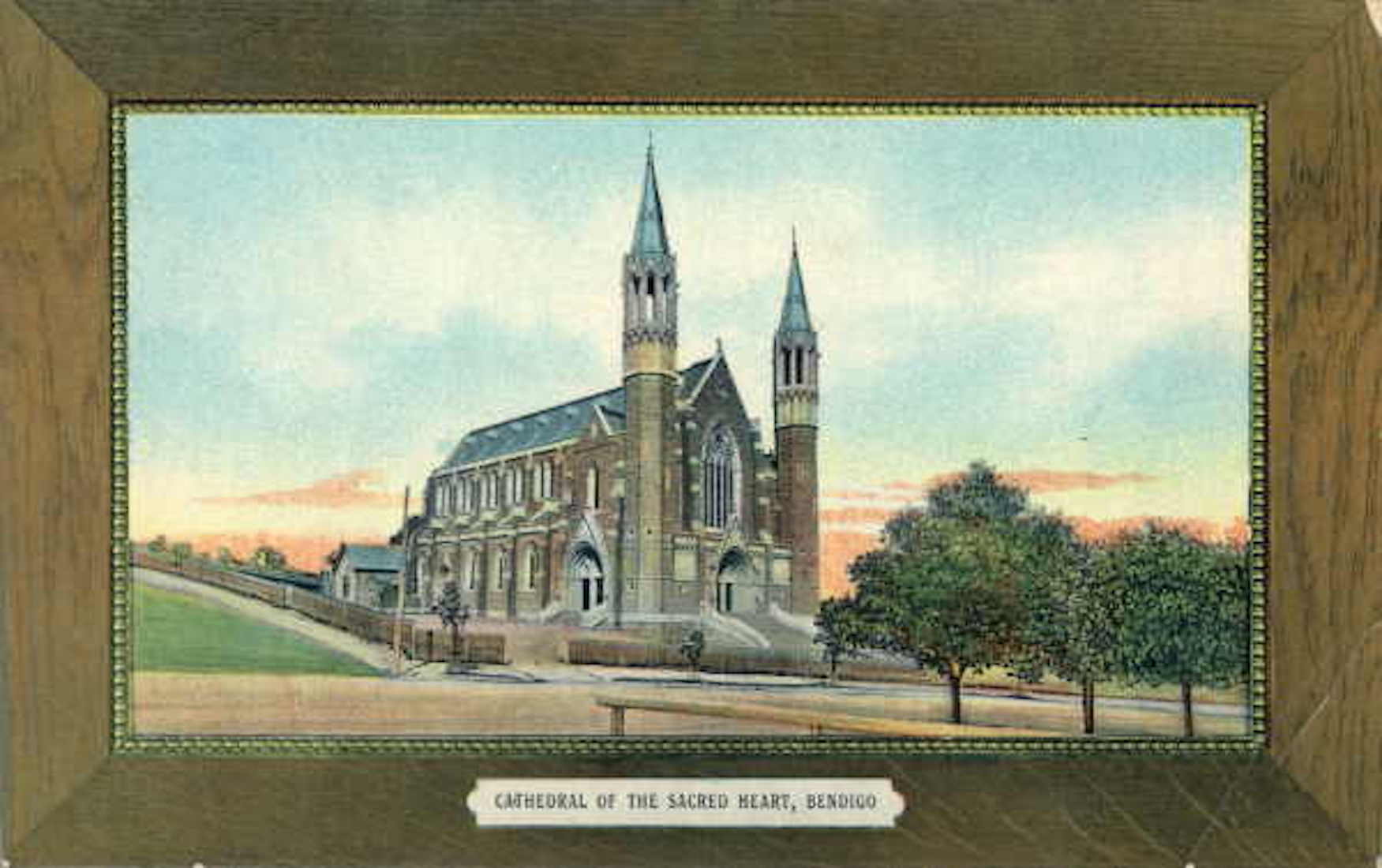
The brass eagle lectern was the gift of Bendigo’s ‘Quartz King’, George Lansel. There is another which is a duplicate cast from it to provide a book rest for the Presider. PLAN
42. TO THE BLESSED SACRAMENT CHAPEL
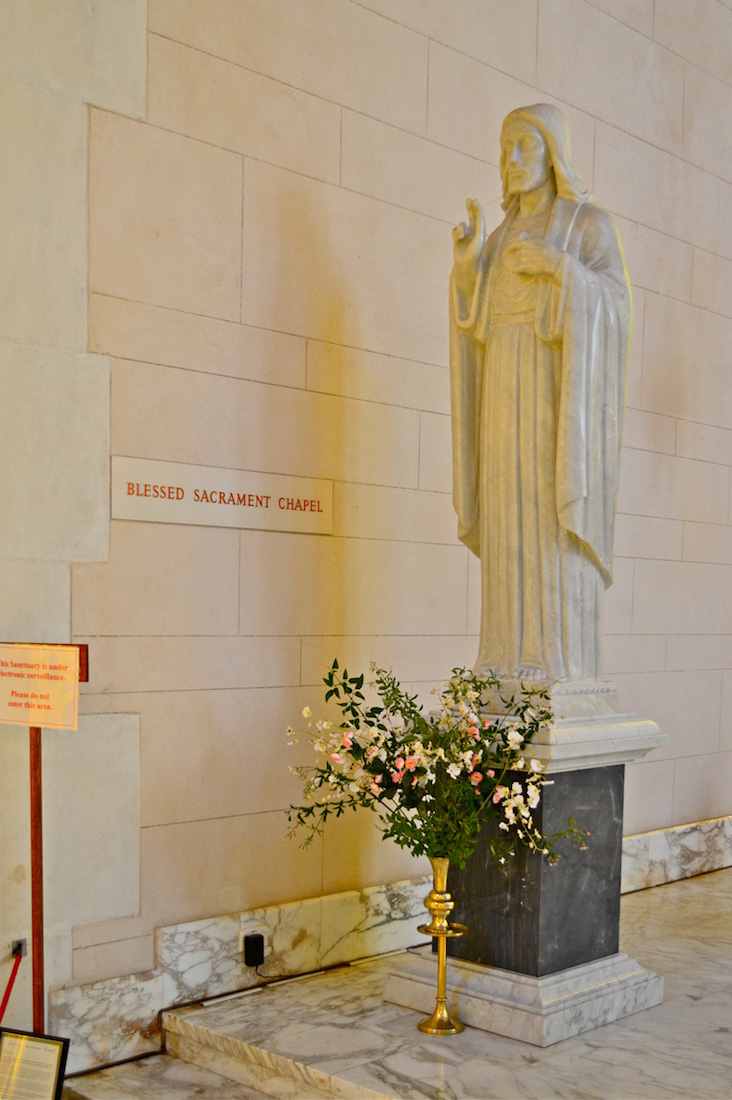
To the left of the sanctuary area lies the Blessed Sacrament Chapel. The welcoming statue of the Sacred Heart was sculpted by Mariano Fracasso.
43. BLESSED SACRAMENT CHAPEL
The Chapel of the Blessed Sacrament ... . We notice the band of mosaics similar to those in the Lady Chapel, and created by Anne Graham. The chapel was dedicated by Bishop Bernard Stewart of Sandhurst: ‘A memorial to all who shared in this glorious work of completion of the Cathedral’.
44. CHAPEL ALTAR
We see here the altar of the Blessed Sacrament Chapel. The series of mosaics behind are in rich orange, yellow, red and gold, and depict new life and sacrifice. The altar contains relics of Ss John and Paul. They were brothers and Romans who were martyred in 362 under Julian the Apostate. The mosaic enamel cross on the altar was brought back to the cathedral by Bishop Reville after one of his visits to Rome. It is an 18th Century gold and enamel crucifix depicting the famous churches of Rome around its base. On the front of the tabernacle on the altar are two exquisite figures of St John and Our Lady by the silversmith Dan Flynn. These and the tabernacle are covered in gold leafing by A. Pierini. On the front of the altar is a scene of the Last Supper by Stanley Hammond.
45. ST FRANCIS CHAPEL CEILING
We next come to the octagonal St Francis Chapel with its beautiful ceiling. The wood in the ceilings of the octagonal chapels had to be put into heated water tanks so that it could be bent into the correct shape. All the woodwork in the new section of the Cathedral was carried out by local Bendigo craftsmen, Frank and Paul Coppock.
46. ST THÉRÈSE
Each of the chapels houses a statue of the appropriate saint, except for the baptistry which is the Chapel of St Francis Xavier, but houses the statue of St Thérèse of Lisieux – ‘the little flower’. She was born in France in 1873 and died of tuberculosis aged 24, It is likely she would have remained unknown had she not written L’Histoire d’une Ame (Story of a Soul) which was translated into many European and Asian languages and became very influential. In it she promoted the idea of simple but courageous self-sacrifice and complete obedience as a taxing, courageous and fulfilling life choice. In art, Thérèse is represented in Carmelite habit holding a bunch of roses in memory of her promise to ‘let fall a shower of roses’ of miracles after her death.
47. FONT
The St Francis Xavier Chapel is also known as the Baptismal Chapel, and contains the baptismal font. This features a variety of inlaid marbles and was originally installed in 1904.
48. TRANSEPT SHRINE TO MARY
This shrine to Mary is located in the North Transept. Photographs from ca 1914 show the shrine in the then Lady Chapel – on the left side of the Sanctuary. It is thought that the upper part of the Shrine once housed the crucifix which now stands on the tabernacle in the Blessed Sacrament Chapel.
49. SHRINE DETAIL
The top section of the shrine now displays the painting of our Lady of Good Counsel. Little is known of the history of this painting.
50. SHRINE DETAIL
The lower section of the shrine contains a painting, source and author unknown, of the traditional scene of Mary giving the rosary to St Dominic. The tradition dates back to the 13th Century – the rosary being a great aid to prayer. The painting was damaged and repaired in 1982.
51. NORTH TRANSEPT ROOF
The ceilings in this Cathedral are a delight, as this ceiling in the North transept. The timbers are oregon and kauri with mouldings of yellow and sugar pine, and panels of King William pine.
52. ST PATRICK
Leaving the North transept we come to the octagonal St Patrick’s Chapel, North West of the crossing. This statue of St Patrick was sculpted by Mariano Fracasso. The chapel was dedicated by Bishop Leo Clarke of Maitland: “A memorial to pioneer Irish Priests and people and to Bishop McCarthy, who built well on their sure foundation” It is intended to “remind the generations to come of their debt and ours to that land where so many of our forebears saw the light of day.” The altar in this Chapel contains relics of Ss Cornelius and Constantine. St Cornelius was Pope and beheaded in 253, and St Constantine was Abbot in the 6th Century, and Scotland‘s first martyr.
53. CROSSING CEILING
The crossing has a very attractive ceiling. Sixteen square wooden panels are set, four to each quadrant, with a central decorative rose. These are recessed back into an octagonal opening and lit from behind (above) from the windows of the belfry above. Interesting questions: how do you gain access to this tower? and how were the bells installed?
54. CLERESTORY WINDOWS
Standing near the crossing and looking up and back along the North Wall of the nave, we notice the upper windows. These are not at all fancy, but serve to make the whole nave light and bright.
55. NAVE STATUE
Above the double doors in the North wall of the nave stands the only plaster statue in the Cathedral. It represents St Vincent de Paul, the champion of the poor. The statue was never removed from the building during the whole time of the internal renovations.
56. ORGAN
The pipe organ was made by Bishop and Sons, London in 1904, and installed in 1906. It was rebuilt in 1951 and 1987. It has over 2800 pipes spread over 5 divisions – four manuals and one pedal division. It is a very fine cathedral organ and highly regarded nationally.
57. WEST WINDOW
The West window was made by the celebrated firm of John Hardman and Co in Birmingham, England. It is a superb example of ecclesiastical glass. It was the gift of Bishop Martin Crane. The central figure is Jesus the Sacred Heart. On the left of Jesus is Our Lady, on the right is St Joseph. On the far right is St Patrick, and on the far left St Augustine. At top is the Holy Spirit, in the form of a dove descending on the Apostles. The window is 32 feet high (10.1 m x 4.9 m). Also depicted in the window are blue cornflowers – a symbol of Germany, and a tribute to Rev Dr Henry Backhaus DD. This completes our tour of the Cathedral. Some historical photographs follow.
58. 1901 PHOTO
The current Wattle Street site was originally part of the Backhaus estate, and in 1886 a lease was taken out for 500 years at the annual rate of one shilling! In 1895 Bishop Crane called for competitive designs for a Cathedral, and a Gothic design by the Melbourne firm Read, Smart and Tappin was selected. It was decided to lay the whole foundation, but to proceed only with the building of the nave and the side aisles. The formal laying of the foundation stone occurred in 1897, although at this time substantial progress had been made on parts of the building. This photo shows the Cathedral in 1901.
Credits: the text and the five black and white photos shown here are taken from the Cathedral booklet Centenary Commemoration 1901 – 2001 by M. J. Nolan.
59. 1904 PLAQUE
Just over four years later in 1901, Bishop Reville blessed the new building, and the next day it was formally opened by Cardinal Moran, Archbishop of Sydney and the Senior Catholic Bishop in Australia. The events associated with the opening received extensive coverage in the press. The arrival of many dignitaries provided the opportunity for one of those grand-scale events typical of the times. On the Sunday, the High Mass was a lengthy ceremony lasting three hours and attended by about 1200 people. Set in the Cathedral wall, the plaque shown here will be intelligible to Latin scholars(!), and carries the date MXMIV (1904).
60. 1909 POSTCARD
After the opening, little further work was done on completing the Cathedral for over 50 years. The only structural work undertaken was the completion of the front lantern towers in 1908, and the front granite fence in 1934. Internally, a large pipe organ, built by Bishop and Son of London, was installed late in 1905. In 1951, the Golden Jubilee of the Cathedral was marked very simply with the then Bishop Bernard Stewart offering Sunday Mass. The postcard shows a 1909 view of the Cathedral. It comes from the State Library of Victoria : 24-pc000239.


